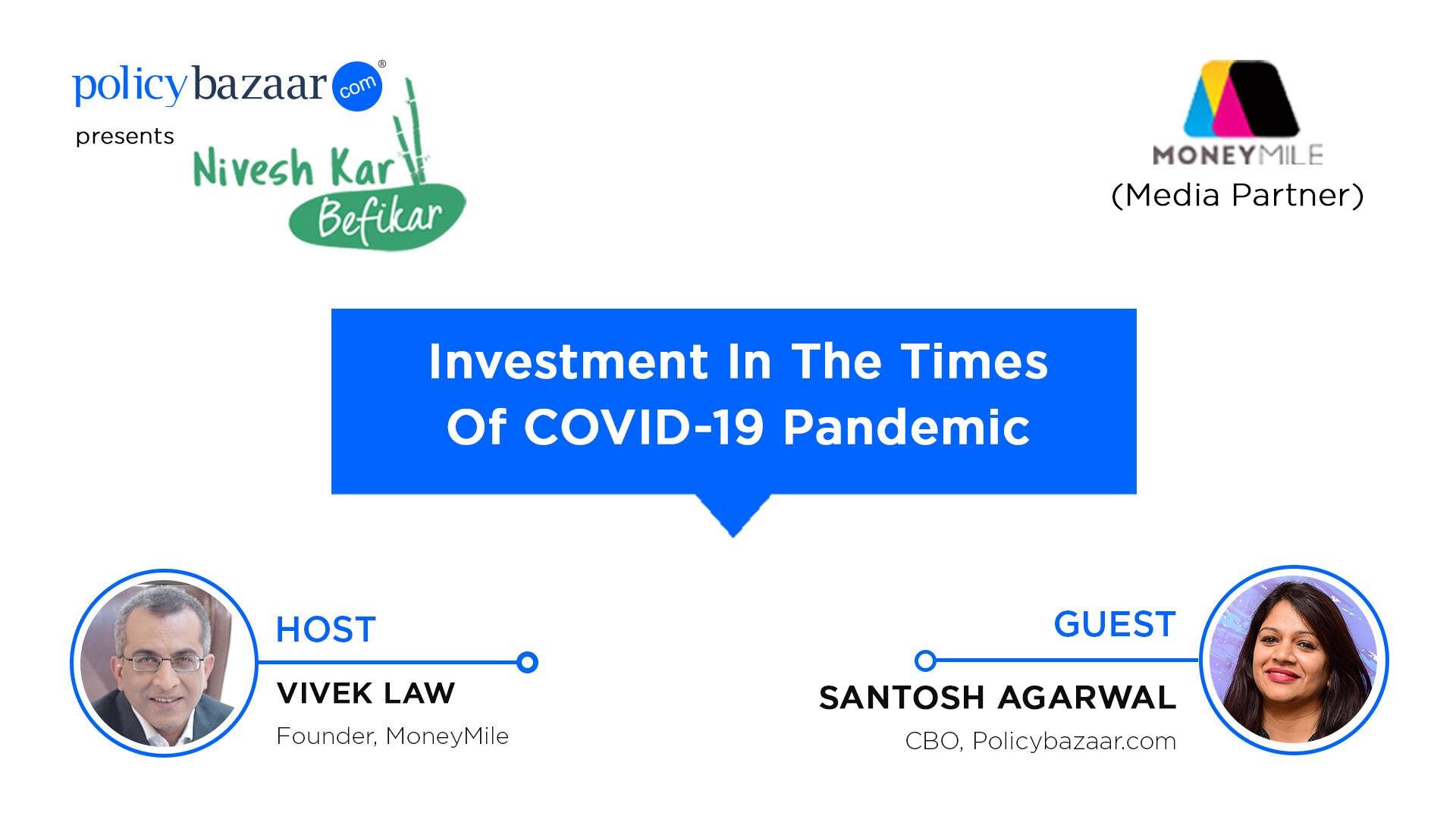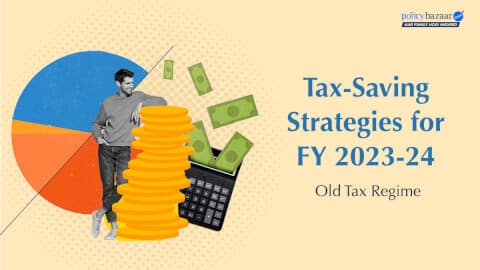1
Q3 FY24: PB Fintech posts strong numbers, PAT positive with 43% revenue growthDecoding Insurance
NiveshKarBefikar with Santosh Agarwal: Investment in The Times of Covid-19
There has been a huge economic impact due to Covid-19 across the globe. The world is reeling under the steepest economic recession and it will take some time to bounce back. Financial markets have fallen and in such unpredictable times, investors are averse to taking risks.
But, however strange that it may sound, falling markets are the best time to invest and Policybazaar.com recently came up with innovative solutions like Capital Guarantee which give 100% capital guarantee to the investor.
In continuation of its consumer awareness initiatives, Policybazaar organized an investment-special webinar, under its Nivesh Kar Befikar series. The webinar was hosted by Vivek Law, founder and editor-in-chief of The MoneyMile, who spoke to Santosh Agarwal, Chief Business Officer (Life Insurance), Policybazaar on Investment in The Times of Covid-19.
Here are the edited excerpts from the Q&A session:
Q. There have been a lot of concerns in the past when it comes to investing through insurance. The returns are way too low in endowment policies. The concern around old age ULIPs is that the costs are too high. Therefore, from an investment perspective, it may not make sense. What about other investment plans like a capital guarantee? What are the reforms that have happened over the last few years?
ULIPs have reformed themselves to the extent that they are as competitive as mutual funds and in some cases more competitive than the latter. If you were to look at a long term saving perspective where you have a goal in mind and to achieve that goal, you have 5-7 years, then you should consider ULIPs. The reason is ULIP allows disciplined saving and the expense ratios are lower than mutual funds. The other big advantage of investing through ULIPs over a mutual fund is that you don’t have to pay any tax on the profit that you make when you invest through a ULIP. However, you will have to pay a tax on Long Term Capital Gain if you invest through mutual funds. That’s a big advantage and will be quite huge when it comes to actual monetary terms. It allows you to change the way you look at investment through ULIP and you will consider it as an efficient tool to invest. However, your time horizon should at least be 5-7 years. If your time horizon is lesser than that, you should still opt for a mutual fund because ULIPs need a five year period of lock-in.
When investing money in a mutual fund and ULIP, you are investing in the market. So, there are risks associated with it. Though they get minimized in the long term. But there is a risk element because its equity at the end of the day. There are other ways to invest for people who are less averse to risk and are fine with a muted return but want their capital to be protected or would not want to face a risk of using the money they invested. If you are that kind of customer then, you have two or three options. The option is debt and if you invest through that route which is government security or corporate bonds, the risk of market volatility is significantly reduced. So, one way of doing that is investing through a mutual fund or a ULIP. But invest in debt instead of equity. The third way to invest could be insurance and that’s where I would like to focus our discussion today. One should invest in a Capital Guarantee product which is a combination of two products. One is ULIP which gives you exposure to equity but at the same time, the money is split into a fixed income product that invests your money totally into debt instruments.
It’s as good as investing in a fixed deposit if I were to say it in layman language. However, unlike fixed deposits, the returns would be higher and there will be no tax on maturity. That’s the benefit of investing through a fixed instrument insurance product.
You are splitting the investment into a fixed benefit debt product along with equity. So, the money invested can never reduce. Your capital is protected and the split of the amount in equity and debt is decided by the fund manager. So, you don’t have to do that math and as a layman, suppose you were to invest Rs 100 for this product every year for the next 5 years, those Rs 500 will be 100% guaranteed and you will not face any risk in terms of capital and the return the market allows you to make on equity will be the profit that you will make.
So, one can expect a 7-9% kind of a return on the product of this nature with the benefit of capital protection and the entire proceeds to be tax-free.
Q. This 7-9% return is something that some of the new age products are offering because traditionally, endowment plans have not been able to match 5%.
That’s true. If you look at just the fixed benefit part, these are products which are called non-part/profit (word unclear, tried listening many times and checked on the internet also but not sure.. time slot 06:30) endowment products. These kinds of products tell you the majority amount. They will give you in writing that amount can’t be changed. That return itself is about 5.5% which is comparable to a fixed deposit. The other part that you are investing in equity, overall in 5-7 years you should be able to generate about 10-12%. So, the combined return that you will get through investment from a product of this nature, should be in the 7-9% range.
Q. I am 54 years old and I still have 6 more years to retire. I don’t have a pensionable job. How to invest and where to begin with so that I will get some amount every month?
—From Sinthiya Singh
There are two things that you could do. To invest and create a pension for yourself, if you have a lump sum amount available and money collected over a few years, you could buy yourself an annuity product. An annuity is creating a pension for yourself till you live. It's a debt which the insurance company is taking. Once you invest in an annuity, you will get a 6-7% return but the pension that you get will be lifelong till the time you live. However, you have to invest in one go. So, that’s one way to create a pension. If you don’t have a large amount saved yet and you want to start investing today and build a pension after 10 years from now, then you can take a whole life ULIP. Choose a ULIP plan which is a low cost, has only a fund management charge, and allows a policy term of up to 100 years.
That would mean you start a SIP today, invest every month, and after 5 years, you can start withdrawing a pension for yourself and you can also decide what pension allowance you want. So, a fully flexible structure but allows you to invest and withdraw money when you need it and if there were an emergency ten years later for health reasons, or you need to pay off a debt, it allows you to withdraw from a pensionable amount. So, I would say, if you can, you should invest in both. If you have enough money, invest directly into an annuity product and create a pension for yourself. Just remember that this pension will be taxable and the other bit, you start a SIP from today and take a whole life ULIP product. There are many good products like HDFC Life Click to Wealth, Bajaj Life-Long Goal which you can opt for and start an SIP today. Invest over the next 10 years and you will be able to create a corpus wherein you can decide your pension amount and how much you want to withdraw each month.
((relatedarticle_1))
Q. Should the investment currently be more into debt funds than equity as the performance of equity funds is in negative and is not expected to return to normal anytime soon. How does it work in terms of selection of debt vs equity? Is it something that a consumer has a choice or is it something that the fund managers decide?
—From Aparna Das
You have a choice for investing in debt or equity or you could let the fund manager decide it for you. Both options are available. These options are available in the insurance and mutual funds both. For example, if you were to invest in insurance and you picked up a plan like Bajaj Gold Assure, it gives you eight fund options and some will be complete equity- large-cap, mid-cap, and some of them will be totally debt. You can decide if you want to invest 100% into equity and 100% into debt, or you could decide a split like 30% equity and 70% debt or you could let the fund manager decide it for you.
To answer the first bit, the market has been really volatile and it's not just the Covid-19 period, but in the last 3 years, small-cap has given a negative return. So, whether you should invest in equity or not, then I would say that you should get into equity when it bottoms out and this is one of the periods when equity has bottomed out and you should seek correction from here. The market is really low right now and it's a good time to enter against what people think that if the market is going down, you should sell-off. It's actually the right time to enter. So, if you were to invest in equity, I think it's a good time to start. Start with SIP mode so that your risk is minimized and also have a horizon at least 5 years. If you are getting into equity, don’t expect a return next year. If that’s your time horizon, then don’t invest in equity, then invest in liquid funds or mutual funds which are actually debt funds.
Q. I invested in an HDFC Child ULIP Plan in 2010 for a 20 years period and kept the investment at 50% equity and 50% in the growth fund. Both seem to be the same. How much can I expect a return in 2030?
—From Amit Sharma
If you were to take the last 25 years of equity history, we have seen a return of about 15%. Ten years have gone since you started investing in 2010, if I were to add the next 10 years, I think the annualized return should be at least in the 10-12% range. So, when you exit the product say 10 years hence, you should be able to generate an annualized return of 10-12% on your product.
Q. I have invested Rs 11 lacs in a ULIP by ICICI Pru Life but its performance is negative now. What should I do? Can I quit from ICICI Pru Life and invest in a capital protection plan?
—From Satish Singh
If you have invested in equity which may be mid-cap in a ULIP, the return could be negative. Two things you can do. One, you could switch the money that you have invested from equity to debt in the same product. You don’t need to exit that product. You can keep investing and whatever amount has got invested, you can switch that money from equity to debt. Once you invest money in debt, there should be no capital erosion. You will get a return on the money in 6-9% kind of a range. That’s one thing you can do. But switch in the same product- equity or debt funds.
Q. In a lot of older generation endowment plans, the problem was that if you wanted to exit, there is so much charge before the culmination of the policy that it probably makes more sense to stop paying your premiums further. Instead, make fresh investments in other products. What would you advise a customer who is probably stuck in an older product? Since costs are very high and they are seeing a negative return, so they may invest somewhere else.
If you bought an endowment product, where you withdraw your money for maturity, you almost tend to lose. If that’s the product that you have invested in, the best way is to make it paid up. If you withdraw it, you probably don’t even recover the money that you have invested. Making the policy paid-up means that you will stop investing further but the amount that you have invested will stay protected and that amount will be returned to you at the due maturity date. Say, if you have invested in 2010 and the maturity date is 2025, you can stop investing further now because you have already invested for 10 years and you can make the next set of investments in a more efficient product. But the amount that you have invested so far, will continue to be protected. Your return will also be protected and this amount will be returned to you in 2025 which means you won’t lose out the amount invested so far and there isn’t any penalty on your amount. So, make it paid up, don’t withdraw it today. Withdraw it at the due maturity date and you can continue investing in a more efficient product. Paid-up is a better option than withdrawing.
Q. I am 28 years old and I want to invest in a ULIP to cater to my pension. However, I also want to get returns every 10 years. Is there any specific plan?
—From Shoaib Shikari
You could use the whole life ULIP option for pension creation for yourself which allows you to withdraw every 5 or 10 years. You can decide how much you want to withdraw. There will be no restriction. You can invest in HDFC Click to Wealth Plan or a Bajaj Lifelong Gold Plan that allows you to invest in a monthly mode through a SIP mechanism and you can start a pension 10 or 15 years from now. You can also decide the pension amount. In between, if you have to withdraw a larger amount for one-time usage, you can also do that. So, whole life ULIP could be a good option for you to start with.
Q. Suggestions around debt products. Currently, my fund is in a Multiple Cap growth and opportunity fund ICICI Pru Life. Should I switch to an income fund? Is an income fund like an FD?
So, FD and income funds are debt instruments. The difference here is that one could be just government securities and one could be a mixture of government securities or corporate bonds. But both are equally secure and the better option would be to switch to a debt fund. An FD will attract tax on the profit that you make. Whereas the profit will be completely tax-free for a debt fund in insurance. So, whatever investment you make, you can switch from opportunities to debt funds and you should expect a decent range of return and the amount (profit) will be tax-free.
Q. I am 21 years old. I want to invest money in my higher education. Please suggest which plan gives a good return after 5 years of investment so that I can continue my education with that return amount.
—From Akshay Jaiswal
You should choose a direct ULIP product which means there are no charges on the product apart from the fund management charge. Given that you want good returns in five years to continue your education, you could choose a ULIP which is Capital Guarantee which means that the money that you invest will not erode. You could invest in HDFC, Bajaj, Edelweiss, or SBI. Choose a Capital Guarantee product to invest which is a ULIP with 100% allocation into debt or choose a solution that is available where some amount gets invested in ULIP equity and some amount gets invested in fixed benefit products. Those solutions are available on Policybazaar.
((relatedarticle_2))
Q. Do 4G ULIPs which are low cost that you talked about, have child plans as well? There are a lot of questions around that. What’s the best investment policy for students? Can you have a structured child plan with the rates of new 4G ULIPs or are those just standardized investment products?
—From Abhishek Kumar
All of these products are 5G ULIPs which have a strict xxx (word unclear in the recording time slot 21:49) structure. These products only have a fund management charge and even the mortality charge is returned at the end of the maturity period. All of these products have a child variant as well. It allows you to stay invested and whoever is the proposer or parent who is making an investment in the child’s education, if any unfortunate incident happens to the parents, the future premium will be paid by the insurance company which means that the final fund/amount that you had set the goal for, that amount is protected.
They do have a child variant. So, if you check HDFC Life Click to Wealth, there is a child variant called a waiver of premium option. Bajaj product called Future Gain also has a waiver of premium option. Max Life Online Savings Plan also has a waiver of premium option in which if the parent dies, there is a sum assured which is paid to the child right away and the future premiums will be waived off. Insurance companies will pay the future premiums and the final fund value which is the goal investment amount that you wanted to create for your child will also stay protected and will be paid out.
Q. Why can’t we reduce the minimum premium amount to Rs 1500 during the pandemic?
—From Sheikh Zahid
There are a couple of options which are available starting at Rs 1000. If you were to check the HDFC Life Click to Invest product which is a 5G ULIP where there are no charges apart from fund management and mortality charge. That product is available starting at Rs 1000 per month. There are other options like Max Life Online Savings Plan which starts at Rs 1000 per month SIP.
Q. What’s the best investment in the times of Covid-19? Also, just to clarify, there are a lot of questions coming in 1 or 2 or 5 years from the horizon for investing through insurance.
—From Raja D, Ratan, Feroz, Dr. S Ganesh Babu, Shankar Mandal, Debashish Chakraborty, and Arindam Chakradhar.
If your horizon of investment is less than 5 years, then insurance is not the product for you. If you were to look at other options, you can consider mutual funds. If you have a shorter horizon which is 1 or 2 years. Even then, just be careful that you don’t invest through a small-cap or mid-cap. Invest through large-cap. Given the pandemic, you don’t know how small-cap companies may survive and how their balance sheets will look like. So, you better stay invested in large caps. At least if you were to start today, choose mutual funds, either debt or large-cap equity.
Q. Is there a combination of endowment plans available with a health insurance policy?
—From Amar Lal Wadhwani
There isn’t a readily available solution. Even if one was to create a readily available solution, there won’t be a unique benefit combining the two. One should just go with the investment option and when you say endowment, I would suggest going for a fixed benefit product like Sanchay from HDFC Life which gives a 5-5.5% return. These returns are guaranteed and tax-free, unlike an FD. So, you are better off investing in these. In such products, returns are fixed for the next 15-20 even up to 40 years. You can choose a time horizon as long as that. So, choose that for your investment objective and go for a regular health insurance indemnity product to cover yourself for health. Nowadays, there are products available which offer you up to Rs 1 crore health protection at affordable prices. If you are 30 years old, you will get health insurance of Rs 1 crore sum insured at the cost of only Rs 10,000 a year. Just one year back, this was the amount you would pay for a Rs 5 lac cover.
Q. What happens if the insurance company providing ULIPs go bankrupt?
—From Nishit Bhandari
Whether it is an investment plan or a term plan provided by an insurance company, if it goes bankrupt and shuts, that portfolio is shifted to another insurance company that is in the market today. It will be serviced by another insurance company. It will never be closed and that’s an IRDAI mandate to insurance. For example, Shriram Life is an insurance company and a lot of customers have bought their products, when that company closes down, another insurance company ICICI Prudential Life will take over their portfolio and continue to service those customers. So, if you buy an insurance policy, it will stay protected. The worst that could happen is that the brand whose servicing you may change but the product can never close down and you can never lose money. That’s one thing which is very peculiar about IRDAI who has done this to protect the interest of policyholders in insurance.
Q. Which plan is best for my six-month-old child for his education? I want to invest Rs 1000 per month.
—From Udhhav
You could start with the Max Life product. It allows you to start with investing Rs 1000 per month. The benefit of this product is if something were to happen to you, Rs 1000 will continue to get paid by the insurance company. The final amount/ corpus that you expect to generate for your child will stay protected. If unfortunately, the parent dies, there is also an additional sum insured. If you invest Rs 1000 per month, you will pay Rs 12,000 annually. There’s a Rs 1.2 lacs sum assured which you will generate which is a protection cover. If the parent dies, Rs 1.2 lacs is paid to the child right away. Rs 1000 per month will continue to get invested and the insurance company will continue to invest your amount, the final corpus will also stay and will get paid out by the insurer.
Q. Which is more beneficial? Investing in a Gold ETF or a ULIP for a 15-year-old horizon?
—From Amit Sharma
You will not be able to take gold exposure. Most insurance companies don’t take gold exposure when they invest through insurance. These are two different investment approaches. If you are taking a 15 years horizon, you could invest through debt funds offered under ULIP which gives more security on investment and you get a decent return which is tax-free.
(Article edited by: Sunny Lamba)
((newsletter))














